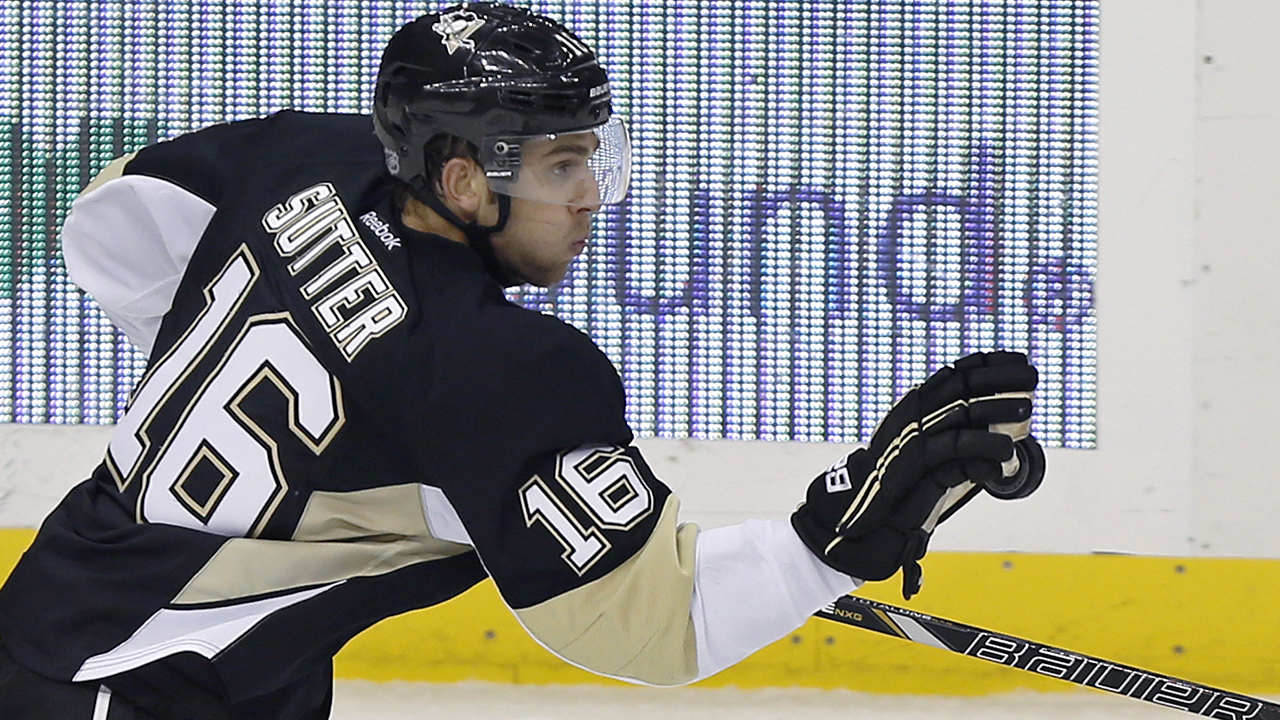In a surprising mid-summer trade with the Pittsburgh Penguins, the Vancouver Canucks paid a premium to consummate a lateral move on the trade market.
The Canucks swapped 27-year-old pivot Nick Bonino, prospect defenceman Adam Clendening, and the 2016 second-round draft pick that the club received from the Anaheim Ducks in the Kevin Bieksa deal, in exchange for defensive centre Brandon Sutter and their own 2016 third-round pick, which has changed hands more frequently than Mike Sillinger.
It’s a trade that won’t help us make sense of Vancouver’s messy, halting rebuilding effort.
Sutter is an ace penalty killer who has been criticized for his lack of offensive production and his pedestrian performance by the shot-based metrics. Though the Penguins surrendered goals against at a very low rate when Sutter was on the ice at 5-on-5 relative to how they fared otherwise during his Pittsburgh tenure, it’s fair to say that Sutter never really lived up to his billing as the centerpiece of the Jordan Staal trade.
He’s bigger and faster than Bonino, but he’s less productive and more expensive. In the Canucks’ eyes though, he’s a better fit.
“They have different skill sets,” Canucks general manager Jim Benning told reporters Tuesday of the difference between Sutter and Bonino. “Sutter is a good two-way player, a matchup guy. He brings us speed through the middle of the ice, and I think it solidifies our centre ice (position).”
In Benning’s view, Sutter’s speed and size is a key reason why he’s an upgrade over Bonino, in spite of the latter’s superior level of offensive production.
“I think the West has gotten real fast,” Benning said. “There are teams that are built one of two ways; there are big, strong, physical teams that control the puck and play a heavy game and the other thing that we’ve seen is real fast teams–teams that play with speed. I think Brandon’s going to help us out in that area… He’ll help with our overall team speed.”
It’s hard to argue with Benning’s reasoning here. Though the Canucks managed to hang with the Big Three California clubs last season, faster sides like the Calgary Flames, Colorado Avalanche and the Dallas Stars exposed them repeatedly.
Bonino may have exceeded reasonable expectations during his only season with the Canucks, during the regular season at least, but his lack of speed and size limited his effectiveness. He was, in no uncertain terms, a liability in Vancouver’s first-round playoff series loss to the Flames.
During a Tuesday availability with the media, Benning – an old school hockey mind if ever there was one – invoked the spectre of playoff performance in describing what he likes about Sutter’s game.
“He’s a playoff player,” Benning said of Sutter. “When the games mean something that’s when he’s at his best.”
Though Benning praised Bonino’s contributions at length during Tuesday’s conference call, it’s hard not to hear an indirect criticism of Bonino’s edge-less performance in the post-season. One can also detect an echo of Anaheim Ducks head coach Bruce Boudreau’s comments last summer about upgrading from Bonino and Mathieu Perreault to Ryan Kesler and Nate Thompson.
For a variety of reasons, the notion that Sutter may fit in better with the Canucks than Bonino did, particularly with 20-year-old pivot Bo Horvat positioned to take on more responsibility and the club desperate for a right-handed centre, appears to hold water. Certainly the club is high on Sutter, and intends to extend the 26-year-old, who will be an unrestricted free agent at the end of the 2015-16 season.
What should be tougher to swallow for Canucks fans is the value of this deal. Bonino has his warts – particularly when it comes to his overall two-way game – but at worst he’s a comparable player to Sutter, and his contract is among the most favourable in hockey. You won’t find many other reliable, productive depth centres signed for the next two years for less than $2 million per.
So why, exactly, were the Canucks left paying a premium in prospect wealth (Clendening) and draft picks?
Benning’s comments on Tuesday suggested strongly that this was Pittsburgh general manager Jim Rutherford’s play from the get go. His comments paint the Canucks as the reactive party, both in the initiation of trade talks right through to the haggling over specifics.
“Rutherford first approached me around the draft about this, so we’ve been talking different scenarios, then the last couple days it kind of all came together. But we’ve been working on it for a month,” Benning said of the process that led to the trade.
“This is an asset that PIttsburgh asked about, inquired about, so to make the deal we put Adam in the deal,” Benning later added of Clendening’s inclusion.
That the Penguins appear to have netted much of what they wanted in trading a comparable, more expensive asset with less term to the Canucks is made even more evident by the clever use of their newly created salary cap space to sign useful, unrestricted free agent forward Eric Fehr on Tuesday.
Rutherford, it would seem, had a plan. If the Canucks have one, it’s becoming harder to detect.
“I think some of the moves we made this summer were to help our team get better now and in the future, but also give us that edge we need to compete in the playoffs,” Benning said Tuesday.
Benning’s Canucks occasionally appear to be rebuilding, except when they’re trading excess assets in lateral trades.
Because of his physical tool,s Sutter may be a better fit with the Canucks than Bonino was, but for the second or third time this summer following a trade, it’s difficult to see where the value is for the Canucks in this deal.










